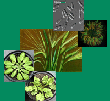| Clemens, S: Evolution and function of phytochelatin synthases, Journal of Plant Physiology, 163, 319-332 (2006), doi:10.1016/j.jplph.2005.11.010 | |
| Abstract: Both essential and non-essential transition metal ions can easily be toxic to cells. The physiological range for essential metals between deficiency and toxicity is therefore extremely narrow and a tightly controlled metal homeostasis network to adjust to fluctuations in micronutrient availability is a necessity for all organisms. One protective strategy against metal excess is the expression of high-affinity binding sites to suppress uncontrolled binding of metal ions to physiologically important functional groups. The synthesis of phytochelatins, glutathione-derived metal binding peptides, represents the major detoxification mechanism for cadmium and arsenic in plants and an unknown range of other organisms. A few years ago genes encoding phytochelatin synthases (PCS) were cloned from plants, fungi and nematodes. Since then it has become apparent that PCS genes are far more widespread than ever anticipated. Searches in sequence databases indicate PCS expression in representatives of all eukaryotic kingdoms and the presence of PCS-like proteins in several prokaryotes. The almost ubiquitous presence in the plant kingdom and beyond as well as the constitutive expression of PCS genes and PCS activity in all major plant tissues are still mysterious. It is unclear, how the extremely rare need to cope with an excess of cadmium or arsenic ions could explain the evolution and distribution of PCS genes. Possible answers to this question are discussed. Also, the molecular characterization of phytochelatin synthases and our current knowledge about the enzymology of phytochelatin synthesis are reviewed. |

